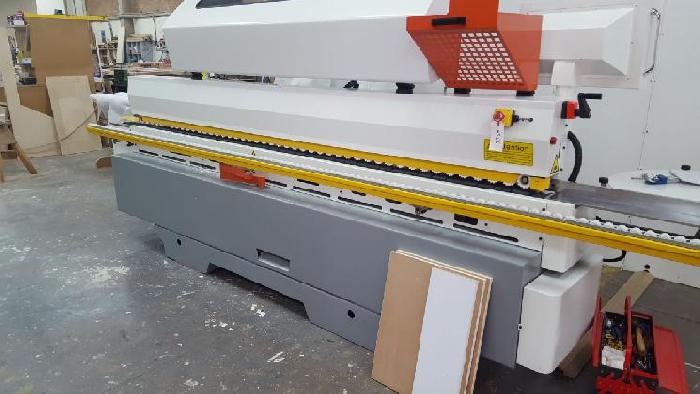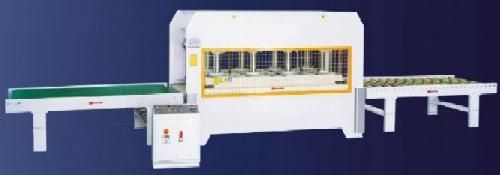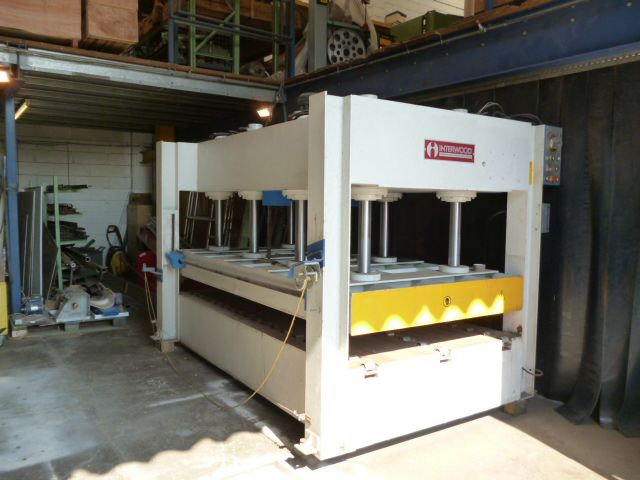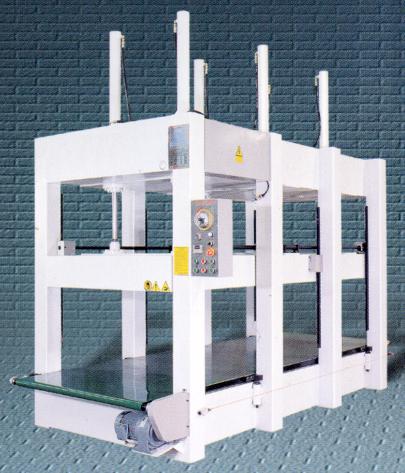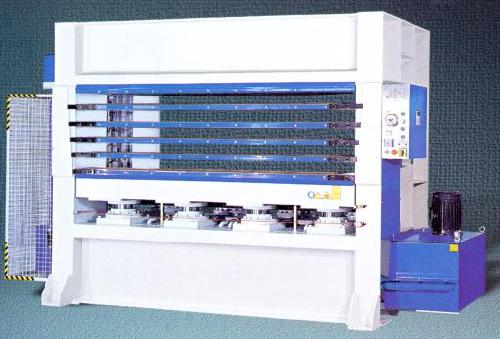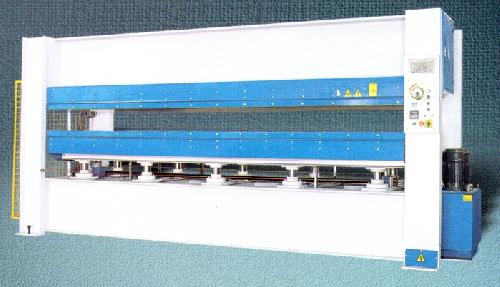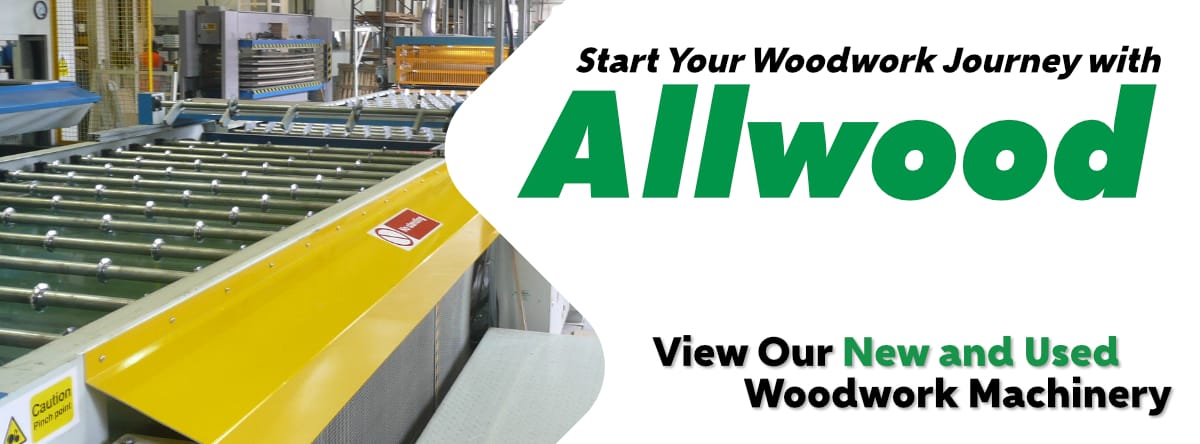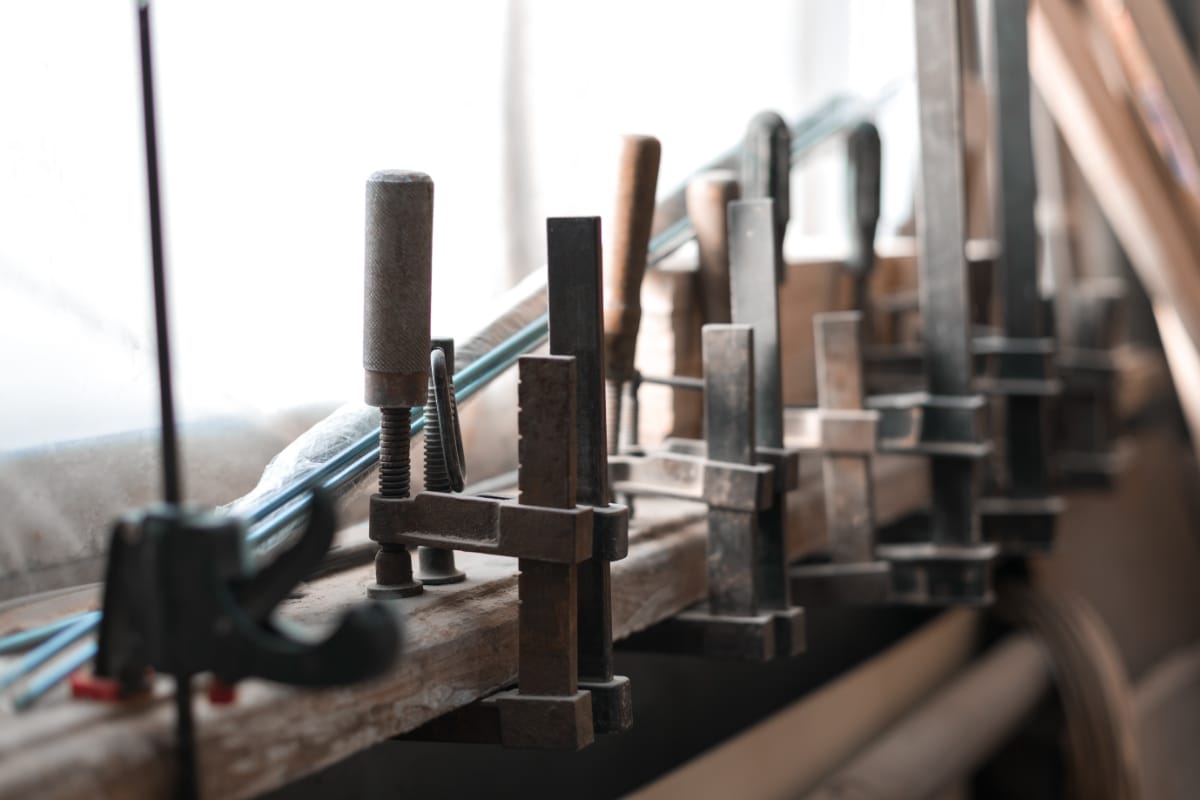Glossary of Woodworking Machinery and Their Uses
Air compressor:
A machine that uses compressed air to power tools and other equipment. Air compressors are often used in woodworking to power sanders, nail guns, and other tools. Modern machinery often requires pneumatic pressure, be it for saws, sanders, impact wrenches, grinders, spray guns, washers, stapling, nailing or pneumatic tooling, the compressor has become a necessity.
The compressor consists of:
- motorised pump
- tank for storing the compressed air
- on/off control
- regulator
There's also a metal frame on which all the parts are mounted, usually with a carrying handle and occasionally wheels.
There are lots of different types of compressors on the market. You need to consider portability and output when buying. You'll want a light compressor if you've got to move it between workshops on a daily basis, and the output has to meet the requirements of the machinery that will be using it.
Bandsaw:
A saw with a continuous blade that moves back and forth. Band saws are used to a variety of cutting tasks, including curves, circles, and irregular shapes. See saws for other saw types.
Belt sander:
A sander with a continuous belt of sandpaper that moves back and forth. Belt sanders are used for fast sanding or large areas.
Biscuit joiner:
A machine that cuts slots into wood so that biscuits (small wooden dowels) can be inserted to join the pieces together. Biscuit joiners are a fast and easy way to join wood pieces.
Boring machines:
Boring machines are used to bore holes or recesses in wood. This can be used for wooden pegs which hold mortise and tenon joints together.
Brushing machines:
Brushing machines are used as a labour saving tool to clean wood before other work is carried out, such as, gluing wood panels.
Combination machine:
A machine that combines the functions of two or more woodworking machines, such as a table saw, a jointer, and a planer. Combination machines can save space and money, but they may not be as versatile as individual machines.
Cramps:
Cramps and presses are used to assemble the wooden pieces that make up window, door or other types of frames.
Dust extraction:
Dust extraction when working with wood is very important for the health of your lungs. There are several solutions, either large machines that draw the dust away. Or small bags that fit directly to the machine which sucks the sawdust straight into it, helping to cut down the amount of dust in the air.
Drill Press:
A drill press is simply a fixed in place version of a hand drill. It uses a rotating drill bit to make holes in wood. Drill presses are often used for precision drilling. With an adjustable table beneath the chuck with a hole in its centre, a spinning drill bit can pass cleanly through a work-piece.
Drill presses come as either freestanding floor models or for worktops. The drill press is powered by an electric motor, driving it via a system of pulleys or gears. The drill bit is locked into the chuck, then driven down using a hand powered lever system, and a spring pushes it back up when pressure on the lever is released. A number of adjustments including a moveable table depth, a depth gauge to set the distance the spindle travels and pulley adjustments to change speeds increases the tools functionality.
A drill press can be used to drill round holes, sanding, grooving and mortising with the addition of specialised attachments.
Jointer:
A machine that smooths and straightens the edges of wood boards. Jointers are often used to prepare wood for use on other woodworking machines.
Lathe:
A machine that rotates wood stock against a sharp tool to shape it. Lathes are used to make a variety of turned objects, such as bowls, pens, spindles, balusters, and chair legs. Work-pieces are suspended over a metal bed, spun at high speed, and shaped using special chisels and gouges.
The wood is fixed between the headstock and tailstock of the lathe. The headstock houses the motor that spins the work-piece. The tailstock is adjustable, moving along the length of the bed to fit work-pieces of various lengths. Once the work-piece is locked in place, the tool rest is set into position. The spinning work-piece is then shaped using a chisel or gouge held fast to the tool rest. Face-plate turning, in with the work-piece is fastened with screws to the face plate of the drive spindle, allows the woodworker to produce bowls and other hollow goods.
Presses:
What is a Pressing Machine, And How Does it Work?
Pressing machines are also known as forming presses. A machine press is a tool used in the manufacturing industry to deform/shape a work-piece under high pressure. There are different types of machine presses, including cabinet presses, frame presses, solid surface presses, composite presses, multi-daylight presses, cold presses, rubber presses, recycling presses and much more.
The defining characteristic of all machine presses is that they press a work-piece using high pressure to change its shape.
While the exact mechanics vary depending on the type of machine press, most machine presses work by pressing a plate or die onto or against a work-piece. The work-piece can either be manually placed into the machine or a through-feed will automatically place the work-piece in the correct position. Once in position, using hydraulics pressure, the machine press pushes the plate or die against the surface of the work-piece, which causes the work-piece's shape to deform into the shape required by the manufacturer.
Pressure generated by machine presses:
Machine presses rely on high pressure to perform their intended applications. Heavy duty presses use around 1 to 30 tons of pressure. As a result, they are able to reshape most materials, including bronze, copper, aluminium, iron, steel, wood and composites. The high pressure of a press squashes even the hardest metals, allowing manufacturing companies to reshape wood or metal work-pieces into their desired shape.
Through-feed presses:
Through-feed presses are those where the introduction of panels between the plates and their extraction are fully automated in order to reduce the working cycle and manpower costs.
Through feed presses include:
- Loading table
- Press
- Unloading table
The most common application involves gluing a coating (veneer, laminate, composite, PVC etc) onto a substratum (MDF, hardboard, plywood, hollow panels, blockwood etc).
The basic configuration of the pressing line is comprised of a feed belt, an automatic press and a discharge deck. This configuration can be completed with numerous options, such as glue spreaders, polishers, automatic feeders, disk, roller or belt conveyors, automatic assembling stations, panel turners and stackers.
Lines with various degrees of automation can be supplied right up to fully automatic lines that do not require direct intervention by the operator.
Presses come in various sizes and with various powers/pressures. The presses can be easily adapted to fit a businesses personal requirements.
Automated press lines:
Automated press lines are designed in conjunction with all through-feed press options to be fully automatic or semi-automatic. They can start at the brushing stage where the material is cleaned, through to gluing, pressing then cutting.
Down and up-stroke presses:
Modern presses fall into two categories:
- down-acting
- up-acting
A down-acting machine has an upper beam that moves downwards to bring the tooling together.
An up-acting machine has a lower beam that moves upwards to do the same.
Each machine has its own strengths and limitations.
Down-acting press:
A typical hydraulic down-acting press uses a pair of hydraulic cylinders, one on each end, to generate the tonnage required for the down stroke of the machine. Traditionally, these machines have a C or O frame profile design. With both types, when facing the front of the machine the hydraulic cylinders are located on the left and right hand side of the upper beam.
Since the upper beam is being pushed down and up with hydraulic power, the upper beam will fall during a power outage and could create an unsafe environment. Down acting presses are commonly blocked at night to take pressure off of the hydraulic system. The lower beam does not move during bending so the operator will not get feedback that the brake is engaged.
Up-acting press:
Up-acting machines typically apply hydraulic pressure from the centre of the lower beam which pushes the lower beam upwards into a fixed upper beam.
Tonnage is applied to the centre of the lower beam in an upward fashion. The flex in the bend tends to be even from left to right. Hydraulics are used to push the lower beam up and gravity is used to return the lower beam down. A loss in power will result in the brake being in the open position. Since the lower beam does move during operation, feedback to the operator is given. Knowing the lower beam is moving can be a safety feature.
Stage bending:
Down-acting machines are preferred if staged bending is important. Staged bending is a valuable option that can significantly improve productivity while minimising setup time.
Up-acting machines can limit staged bending because of the possibility of ram tilt, staged bending may not be a viable option on an up-acting machine. Because staged bending utilises multiple stations on one machine, if any of the stations on an up-acting machine are too far from the centre, ram tilt may result.
Hydraulic presses:
Hydraulic presses come in many different forms and are used in many different industries.
The basic structure to all presses is a heavy-duty main frame with hydraulic cylinders. The number of cylinders are dependent on the pressure requirement. They are operated by a hydraulic power pack.
The presses can be manufactured with heated or cold platens and can have conveyors fitted to make the presses automated.
Presses have advanced over the past decade, enabling manufacturers to improve their efficiency and flexibility.
Typical woodworking presses provide different solutions, such as heated, cold, vacuum, or frame and if you can't find exactly what you need Allwood can design and make a machine for you.
Platen presses:
Presses that operate plane to plane are called platen presses.
Virtually any component that goes into a wood or composite panel construction can be manufactured in a process utilising a cold or hot platen style press.
Hot and cold presses:
Hop presses use heating platens or rollers, heated with steam, oil or electricity.
Cold presses use ambient platens, or rollers to generate force. The amount of temperature, pressure, time and moisture content all factor into how the process works.
Multi-daylight presses:
A multi-daylight press enables the pressing of multiple panels in one go. Used for veneering chip board, MDF and laminate panels, as well as doors.
Veneer presses:
A veneer press uses pressure to hold a veneer against a work-piece to shape and attach while the glue sets. Often used in a system including but not limited to:
- brushing machines
- glue spreading machines
- guillotine
Veneers can be glued to chipboard, MDF, laminate panels, bathroom panels, doors, worktops and much more.
Composite presses:
Composite presses deal with composite materials that need to be shaped into a usable product.
The automotive trade use them to shape carbon fibre panels and battery boxes for electric cars.
The aero space industry use them for shaping light weight panels and seat covers.
The military use them to create bullet proof floor pans for military vehicles.
The refrigeration industry use them to create cold storage insulation panels for fridges.
Laminating press:
The job of a laminate press is to bond layered materials together to create a stronger material than the original, and also for cosmetic purposes. Many laminating processes involve coating a film, plastic, metal, wood, or other substrate with a surface to strengthen it to be used for a much broader range of purposes.
Laminating is primarily a process used to create building materials for construction so they can handle a larger workload and/or not be easily damaged. They are also used to make furniture decorative - see veneer presses.
Rubber presses:
A rubber press deals with materials made from rubber that need to be shaped into a usable product, such as aircraft tyres, as well as rubber or PVC conveyor belts for use in supermarkets and agricultural, industrial and recycling industries, as well airports.
Punch presses:
A punch press looks like an ordinary machine press, but it's used to create holes in work-pieces rather than to change the shape. Typically controlled via a CNC machine, a punch press holds a die that's forced against a work-piece using the same high pressure as created by the traditional machine presses. The presence of the die allows the punch press to create holes in the work-piece.
What Allwood provides
Thanks to years of experience in designing and developing presses for the wood industry, Allwood now offers a wide range of models with specific features designed to meet different production requirements for the wood, plastics and metal-working industries.
Virtually any component that goes into a wood or composite panel construction, can be manufactured in a process utilising a cold or hot platen style press.
You can view all of our current presses on our website, but if you can't find what you are looking for please do not hesitate contacting us.
Router:
A machine that uses a rotating router bit to cut grooves, rabbets, and other shapes in wood. Routers are a versatile tool that can be used for a variety of woodworking tasks.
Sanding machines:
A machine that uses sandpaper to smooth the surface of wood. Sanding machines can be used for a variety of sanding tasks, such as sanding between coats of finish.
Sander - Table and Belt:
The stationary belt sander uses a closed loop of paper that travels at speed around a pair of cylindrical drums. One drum is driven by an electric motor, the other is spring-loaded to maintain belt tension. Powered by the same motor, the stationery disk sander uses sanding disks that spin on a backing plate.
On both the belt and disk sanders the work-piece is presented to the tool (the opposite is true of portable belt and hand held disk sanders which are presented to the work) on stationary sanders, an adjustable worktable or fence can be fixed in front of the sander to position the work-piece during sanding.
Saws:
Band Saw:
The band saw is great for freehand and curved cutting, but its depth of cut also makes it suitable for sawing thick timber. The table tilts on many models allowing for angled cuts. Band saws come in many sizes suitable for the homework shop and a professional workshop.
A band saw is capable of cutting wood, plastic composites and insulation. Most workshops are going to have a band saw because they are so versatile. They cut curves, shapes and deep ripping (cutting a board lengthwise or parallel to the grain).
The Band saw blades are thinner than circular saw blades. A thinner saw blade means less wood is wasted when cutting. Whereas, a wider blade makes it easier to cut a deep straight line. Blade size also varies when it comes to the number of teeth per inch, the kinds of teeth and the thickness of the blade. The fewer teeth the faster but coarser the saw cut, more teeth create finer work and can also be used for cutting metal.
A further benefit is the height under the guides which allows you to cut deeper than you would be able to with a circular saw.
View new band saws
View used band saws
Beam Saws:
A beam saw cuts panels and sheet materials to the size required. It can deal with MDF, insulation, plastics and laminated boards. A clamping beam keeps the boards in place while the mobile saw carriage moves underneath the material.
This type of saw has a computer control allowing you to automate as well as making multiple cuts. These machines can also be linked to computer software that optimises your yield.
A beam saw is designed for repetitive, accurate cutting to size, making them the most cost-effective at precision panel cutting.
Front loading beam saw - the user loads the materials into the front of the machine.
Rear loading beam saw - the user places the materials on to an automatic lift table which will automatically be loaded into the back of the beam saw.
Allwood have various beam saws:
See new beam saws
See used beam saws
Compound Mitre Saw:
The compound mitre saw has become a fixture in the work shop because it is versatile and accurate.
The mitre saw consists of a powerful circular saw mounted on an arm that hinges at the rear of the tool. When the blade is lowered in a chopping motion, it cuts through the work-piece, passing through a slot in the base. The motor and blade can be pivoted with respect to the base for mitre cuts. It is also possible to tilt the blade too, which is handy for cutting crown mouldings which are set at a pitched angle that must also turn around corners. The diameter of the blade determines the maximum cut width.
This saw is sufficient for most jobs.
Cross Cut Saws:
Cross cut saws are perfect when you need to cut across the grain. There are two choices, a blade above the table coming across the wood, or a blade underneath that comes up through the table.
The cross saw with the blade underneath the table keeps the blade at a greater distance from the user so is considered safer. It can also be automated with an automatic feed system which allows you to safely cut multiple pieces in one go, which can be more efficient.
Jigsaw:
Jigsaws are best for cutting tight curves, angles and intricate shapes. Blades for jigsaws are short and straight. They're clamped at the top and bottom and cut in a reciprocating up and down motion.
Most models have variable speeds, but the jigsaw is designed to cut precisely not quickly. Feed the wood to the saw flush to the saw table. Jigsaw blades are thin and easily broken, so take care not to bend, twist, or put too much pressure on them. Drill holes in the waste wood at the tightest corners to help you achieve a clean and neat cut. The depth of the saw throat determines how large a piece of wood can be cut on a given saw.
Multi-rip Saw:
Multi-rips are designed to maximise production speed. So if you want to get the most out of your working day, this could be the one for you.
They have multiple blades and a caterpillar tank track, making them perfect for producing multiple thin sections such as lippings for edge banding or cutting multiples from larger sections to produce mouldings.
Allwood have various multi-rip saws:
See new multirip saws
See used multirip saws
Panel Saws:
Designed to accurately cut large sheets of MDF, MFC, wood, chipboard, composites and plastics. They have a sliding table next to the saw blade, moving the material passed the blade while fully supported.
They can also include a secondary scoring saw blade which scores the lower surface in order to reduce breaks/splits/tears on the underside.
New panel saws can be manual, or electronic which makes them easier to use as they will be more precise and accurate. Optimisation is also an option as this will show the user how to get the best yield from each board.
Allwood have various panel saws:
See new panel saws
The radial arm saw is pretty much a portable circular saw that glides on an adjustable arm suspended over a fixed cutting surface. The blade and motor are connected to the arm by a yoke, which is adjustable along both horizontal and vertical planes, enabling the saw to be swung in a variety of directions.
For cross-cut work, position the board flush with the fence at the rear of the saw and draw the blade across the wood. The bevel lock allows the saw to be tilted for cutting angles. You can set it to the desired angle using the protractor on the saw housing. The saw can be swivelled right or left for mitring, or turned a full 90 degrees for ripping. The blade can also be raised or lowered using a crank. The size of the saw is determined by the dimension of the blade the saw can accommodate. As an example a model using a 10 inch blade would be able to cut work-pieces up to 3 inches thick.
Re-saws are a type of band saw specifically designed to cut large sections of timber into smaller sections. Some re-saws can also be used to cut thick veneers making them a popular choice for the manufacturer of engineered wood flooring.
See new re-saws
These monsters are used to automatically load logs and turn them for cutting.
Whether it's a heavy-duty model that stays in a workshop or a portable bench saw, the table saw is an amazing adaptable tool.
The table saw is simply an upside-down electric handsaw that's been mounted to the underside of a steel table top, with the circular saw blade sticking through a slot in the table. The blade spins on an arbour, it's an axle that can be tilted with respect to the horizontal table top for cutting angles, it can also be raised or lowered to adjust to the cutting depth. The mitre gauge enables the workman to push wood at angles or perpendicular to the blade (cross cutting). A fence can be fixed parallel to the blade for cutting along the length of a work-piece (rip-sawing).
Things to consider when buying a table saw. The larger the blade, the larger the stock that can be cut. The bigger the table top the better for cutting large stock like plywood, but bigger is going to be less portable (fixed machine) and more expensive.
Wall saws are also know as vertical panel saws. This tool is all about space saving, and is perfect when space in your workshop is limited. They can be used in the same way as a sliding table panel saw.
See new wall saws
Planers are usually identified by the width and thickness of the wood they will plane. A 12 inch model is great for most home workshop jobs, but bigger ones would be required for professional environments. Never force the work-piece into the thicknesser or planner as the machine has a feed control that adjusts the speed at which the wood passes the cutter head.
It is important to always follow woodworking safety guidelines when using any woodworking machinery. Some general safety tips include:
By following these safety guidelines, you can help to prevent accidents and injuries when using woodworking machinery.
See used panel sawsRadial Arm Saw:
Re-saws:
See used re-sawsSawmills:
Table Saw:
Wall Saws:
See used wall sawsThickness Planer:
